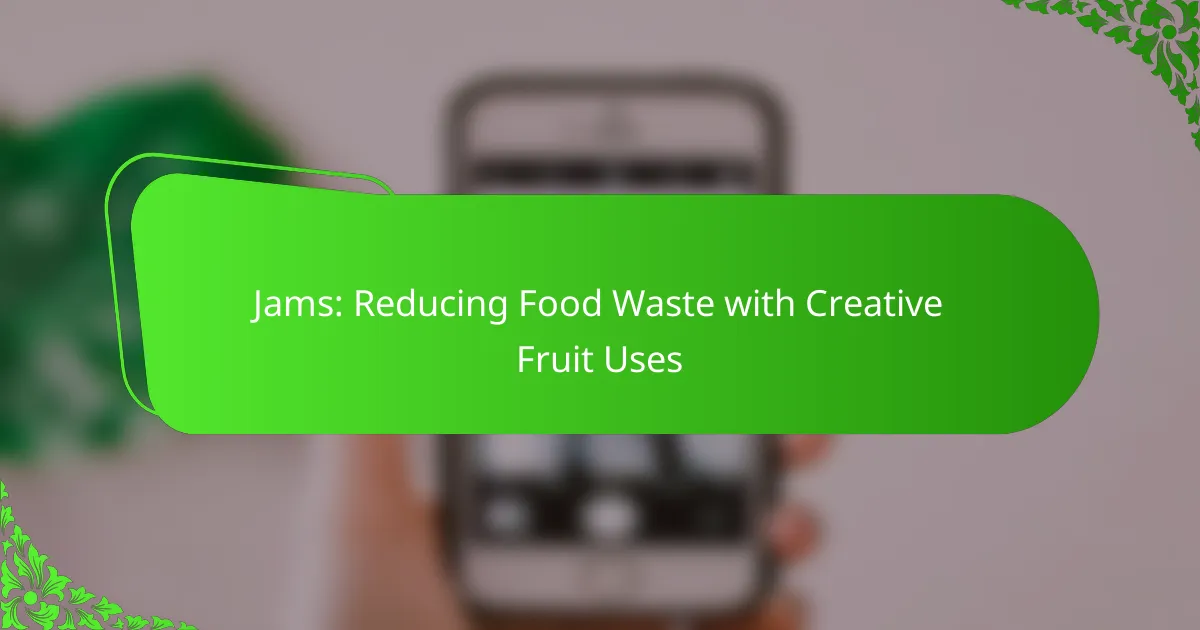Jams offer a practical solution to food waste by converting surplus or overripe fruits into delightful preserves. This not only helps keep food out of landfills but also promotes sustainable practices within communities. By creatively utilizing leftover fruits, you can enhance your meals while enjoying their flavors and nutritional benefits long after their peak freshness.

How can jams reduce food waste in urban areas?
Jams can significantly reduce food waste in urban areas by transforming surplus or overripe fruits into delicious preserves. This process not only prevents food from being discarded but also encourages sustainable practices within communities.
Utilizing overripe fruits
Overripe fruits are often overlooked and discarded, yet they are perfect for making jams. These fruits may be too soft for fresh consumption but retain their flavor and nutritional value, making them ideal for preserves. Common fruits to use include strawberries, peaches, and bananas.
To create jam, simply chop the overripe fruit, add sugar, and cook until it reaches the desired consistency. This method can help reduce waste by giving a second life to fruits that would otherwise be thrown away.
Creating community jam-making workshops
Community jam-making workshops can foster collaboration and creativity while addressing food waste. These events encourage participants to bring their surplus fruits, learn preservation techniques, and share the final products. This not only reduces waste but also builds community ties.
Workshops can be organized in local community centers or parks, and they can be promoted through social media and local bulletin boards. Providing simple recipes and necessary equipment can help participants feel empowered to continue making jams at home.
Partnering with local farmers
Partnering with local farmers is an effective way to source surplus fruits for jam production. Many farmers have excess produce that doesn’t meet retail standards due to size or appearance, which can be repurposed into jams. Establishing relationships with these farmers can help create a sustainable supply chain.
Farmers’ markets or local co-ops can serve as platforms for these partnerships, allowing urban residents to access fresh, imperfect fruits at lower prices. This collaboration not only reduces food waste but also supports local agriculture and economies.

What are creative uses for leftover fruits?
Creative uses for leftover fruits can significantly reduce food waste while adding flavor and nutrition to your meals. By transforming surplus fruits into beverages, snacks, or condiments, you can enjoy their benefits long after their prime.
Fruit-infused beverages
Fruit-infused beverages are a refreshing way to utilize leftover fruits. Simply combine chopped fruits with water, tea, or sparkling water and let them steep for a few hours. This method not only enhances the drink’s flavor but also provides added vitamins and antioxidants.
Consider using fruits like citrus, berries, or melons. For a quick infusion, try placing fruit slices in a pitcher of water overnight. This can be a delightful alternative to sugary drinks and is perfect for summer gatherings.
Homemade fruit leather
Homemade fruit leather is a tasty snack that can be made from pureed leftover fruits. Blend the fruits until smooth, spread them on a baking sheet, and dehydrate in the oven at a low temperature for several hours. This method preserves the fruit while creating a chewy treat.
Choose fruits with natural sweetness, such as apples, peaches, or bananas. You can mix different fruits for unique flavors. Just be cautious with the drying time; over-drying can lead to a tough texture.
Fruit chutneys and salsas
Fruit chutneys and salsas offer a savory way to use leftover fruits in meals. Combine diced fruits with ingredients like onions, peppers, and spices to create a flavorful condiment that pairs well with meats or as a dip. This method enhances dishes while minimizing waste.
Common fruits for chutneys include mangoes, peaches, and tomatoes. Experiment with spices like ginger or cilantro to elevate the flavors. Store chutneys in airtight containers in the refrigerator for a few weeks, making them a convenient option for quick meals.

Which fruits are best for jam-making?
The best fruits for jam-making are those that are ripe, flavorful, and have the right balance of sugar and acidity. Common choices include berries, stone fruits, and apples, as they not only provide excellent taste but also help in achieving the desired texture and consistency.
Seasonal fruits
Using seasonal fruits for jam-making ensures optimal flavor and freshness. Fruits like strawberries, raspberries, and peaches are typically at their peak during summer months, making them ideal for preserving. When selecting seasonal options, consider visiting local farmers’ markets to find the freshest produce available.
In addition to flavor, seasonal fruits often come at a lower cost compared to out-of-season varieties. This can help reduce overall expenses while minimizing food waste by utilizing surplus harvests.
Local fruit varieties
Local fruit varieties can enhance the uniqueness of your jams. Depending on your region, you may find fruits like blackberries, elderberries, or unique apple cultivars that are well-suited for jam-making. These fruits not only support local agriculture but also allow you to create distinctive flavors that reflect your area.
Exploring local options can also lead to discovering lesser-known fruits that may have excellent jam-making potential. Engaging with local farmers or community-supported agriculture (CSA) programs can provide insights into the best local varieties available.
High-pectin fruits
High-pectin fruits are essential for achieving the right gel consistency in jams. Fruits such as apples, quinces, and citrus fruits are naturally rich in pectin, which helps jams set properly. When using low-pectin fruits, consider adding a high-pectin fruit or commercial pectin to ensure a successful outcome.
To maximize pectin content, use slightly underripe fruits, as they tend to have higher levels of this natural gelling agent. Combining different fruits can also enhance both flavor and texture, creating a more complex jam.

What are the benefits of homemade jams?
Homemade jams offer numerous advantages, including cost savings, ingredient control, and the ability to customize flavors. These benefits not only enhance the enjoyment of the final product but also contribute to reducing food waste by utilizing surplus fruits.
Cost-effective preservation
Making your own jams can be significantly more economical than purchasing store-bought varieties. By using seasonal or discounted fruits, you can create large batches at a fraction of the cost, often saving several dollars per jar compared to retail prices.
Additionally, homemade jams allow you to preserve fruits that might otherwise go to waste. This not only maximizes your grocery budget but also reduces the environmental impact associated with food waste.
Control over ingredients
When you make your own jams, you have complete control over the ingredients used. This means you can avoid preservatives, artificial colors, and excessive sugars that are often found in commercial products. You can choose organic fruits or sweeteners that align with your dietary preferences.
Furthermore, this control allows you to cater to specific dietary needs, such as making low-sugar or sugar-free jams, ensuring that your homemade creations are both healthy and delicious.
Customization of flavors
Homemade jams provide the opportunity to experiment with various flavors and combinations. You can mix different fruits, add spices, or incorporate herbs to create unique taste profiles that suit your palate. For example, combining strawberries with basil or peaches with ginger can yield delightful results.
This customization not only enhances your culinary experience but also allows you to create personalized gifts or special treats for occasions, making your jams truly one-of-a-kind.

How to start a jam-making business?
Starting a jam-making business involves creating delicious products while minimizing food waste. Focus on sourcing surplus fruits and mastering preservation techniques to appeal to eco-conscious consumers.
Identifying target markets
To successfully identify target markets for your jam-making business, consider demographics such as age, lifestyle, and dietary preferences. Health-conscious consumers, local farmers’ market attendees, and gourmet food enthusiasts are potential customers.
Research local trends and preferences to tailor your offerings. For example, organic jams may attract a premium market, while budget-friendly options can appeal to families.
Understanding local regulations
Familiarize yourself with local food safety regulations and licensing requirements for food production. In the U.S., for instance, cottage food laws vary by state, affecting how and where you can sell your jams.
Ensure compliance with labeling standards, including ingredient lists and allergen warnings. This not only protects consumers but also builds trust in your brand.
Building a brand identity
Creating a strong brand identity is essential for standing out in the jam market. Develop a unique name, logo, and packaging that reflect your values, such as sustainability and quality.
Engage with your audience through social media and local events to create a community around your brand. Sharing stories about your sourcing practices and production methods can enhance customer loyalty.

What equipment is needed for jam-making?
To make jam, you’ll need a few essential pieces of equipment that ensure the process is efficient and safe. Key items include cooking tools for preparation and canning supplies for preservation.
Essential kitchen tools
The primary kitchen tools for jam-making include a large pot, a stirring spoon, and measuring cups. A heavy-bottomed pot is ideal as it distributes heat evenly, preventing burning. A ladle and a funnel can also be helpful for transferring the jam into jars without spills.
Additionally, a food processor or blender can be useful for pureeing fruits, especially if you’re using whole fruits or larger pieces. A candy thermometer is recommended to check the jam’s temperature, ensuring it reaches the right consistency.
Recommended canning supplies
For canning your jam, you’ll need glass jars with airtight lids, typically pint or half-pint sizes. Ensure the jars are sterilized before use to prevent spoilage. A jar lifter is essential for safely handling hot jars, while a canning rack can help keep jars stable during boiling.
Consider using new lids each time you can to ensure a proper seal. If you’re new to canning, look for a complete canning kit that includes all necessary supplies, which can simplify the process and ensure you have everything on hand.










